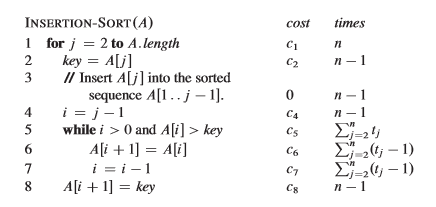Table Of Contents
Input: A sequence of ‘n’ numbers. [a(1),a(2),...a(n)]
Output: A permutation (reordering) of the input sequence such that [a(1)<=a(2)<=...a(n)]
Insertion is a good algorithm for sorting a small number of elements.
- Our function takes an array and the length ‘n’ of the array.
- Compares our current element(key) to its predecessor.
- If our key element value is less than its predecessor, we compare it to the elements before, moving greater elements one position up to create an available index for the swapped element.

Implementation In JavaScript
let insertionSort = function(arr, n){let i, key, j;for (i = 1; i < n; i++){// Current elementkey = arr[i];// Predecessorj = i - 1;// Move elements one position ahead of their current index that is greater than keywhile(j >= 0 && arr[j] > key){arr[j + 1] = arr[j];j = j - 1}// Move key into the proper evaluated positionarr[j + 1] = key;}return arr;}let arr = [21,17,3,11,6];let n = arr.length;insertionSort(arr, n);// Result: [ 3, 6, 11, 17, 21 ]
Maintenance
The inner ‘while’ loop works by moving preceding elements one position forward, opening the correct position for ‘key.’ Due to our loop condition, the loop can execute more than once when our’ while’ loop exits.
Termination
The outer for loop ends when i = n, the array’s length.
Implementation In python
def insertionSort(arr):# Traverse 1 through len(arr)for i in range(1, len(arr)):#Ccurrent elementkey = arr[i]# Predecessorj = i - 1# Move elements one position ahead of their current index that is greater than keywhile j >= 0 and arr[j] > key :arr[j + 1] = arr[j]j -= 1# Move key into the proper evaluated positionarr[j + 1] = keyreturn arrarr = [21,17,3,11,6]insertionSort(arr)# Result: [ 3, 6, 11, 17, 21 ]
Demo with Steps
Conclusion
Insertion sort is an incremental algorithm with an O(n^2) time complexity. Instructions are executed one after the other with no concurrent operations.
Boundary Cases
Best case: The input array elements are already sorted. Worst case: Maximum time to sort when our input array is sorted in reverse order.
Share
Related Posts
Legal Stuff

